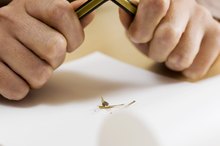Anxiety in Sports
Anxiety in sport is most common in competitive sports environments and could also be termed competitive stress. A lack of consensus makes it difficult to clearly define anxiety and stress in sport, but one definition, proposed by sport psychology consultant Dr. Graham Jones in the book “Sport Psychology: A Self-Help Guide,” is that it’s “the result of an interaction between the individual and the environment … an emotional response to the demands placed upon the individual by the environment.”
Stress
Not all competitive stress is bad, and not all competitive athletes suffer from anxiety. The stresses of competition can be perceived by a competitor as either positive or negative. Positive stress is considered to be an important element of an athlete’s preparation, heightening the senses and leading to a feeling of being "psyched up" both physically and mentally.
According to the Drive Theory, a physically skilled athlete can gain a psychological edge over competitors by harnessing the power of positive stress. Conversely, negative stress can promote feelings of self-doubt, directly affecting an athlete’s ability to cope with the regular stresses of a competitive environment, ultimately leading to a drop in performance.
- Not all competitive stress is bad, and not all competitive athletes suffer from anxiety.
- Conversely, negative stress can promote feelings of self-doubt, directly affecting an athlete’s ability to cope with the regular stresses of a competitive environment, ultimately leading to a drop in performance.
Types
Negative Parental Impact on Athletes
Learn More
Anxiety has two main types:
State anxiety is transient and specific only to the particular situation an athlete finds herself in.
Trait anxiety is more general and enduring, suggesting a predisposition to anxiety in all areas of life, not just in sport.
Symptoms
Symptoms of anxiety are varied and individual to each athlete, but they can generally be recognized on three levels:
Cognitive symptoms relate to thought processes, including fear, indecision, poor concentration, loss of confidence and defeatist self-talk.
Somatic (physical) symptoms include muscular tension, clammy hands and feet, increased heart rate, sweating and butterflies in the stomach.
Behavioral symptoms relate to patterns of behavior, including inhibited posture, fingernail biting, avoidance of eye contact and uncharacteristic displays of introverted or extroverted behavior.
Causes
What to Do When You're Feeling Antsy?
Learn More
Competitive stress becomes negative, potentially leading to symptoms of anxiety, when an athlete perceives what is being asked of him to be beyond his capabilities. Anxiety is often linked to a fear of failure, and an athlete’s perception of his abilities may be based on a previous performance, his beliefs regarding the opposition or the perceived importance of the competition. His perception can also vary greatly from event to event, depending on his perceived state of physical and mental preparation in each case.
Effects
An athlete suffering symptoms of anxiety will inevitably underachieve. The physical and psychological effects experienced will have a negative impact on performance, and continued exposure can lead to burnout, often prompted by growing feelings of dissatisfaction, which can develop into a decision to leave sport completely. The results of a 2009 study published in the online sports psychology journal Athletic Insight highlight the correlation between competitive trait anxiety and burnout in young athletes.
Related Articles
References
- "Sport Psychology: A Self-Help Guide"; Stephen J. Bull; 1995
- Osoria, Fd, Crippa, JAS, Hallak, JEC, Loureiro, SR. Social anxiety disorder, fear of public speaking, and the use of assessment instruments. In: Selek, S, ed. Different View of Anxiety Disorders. 2011. doi:10.5772/18629
- Judge LW, Urbina LJ, Hoover DL, et al. The Impact of Competitive Trait Anxiety on Collegiate Powerlifting Performance. J Strength Cond Res. 2016;30(9):2399–2405. doi:10.1519/JSC.0000000000001363
- Hardy L, Hutchinson A. Effects of performance anxiety on effort and performance in rock climbing: a test of processing efficiency theory. Anxiety Stress Coping. 2007;20(2):147–161. doi:10.1080/10615800701217035
- Alder DB, Ford PR, Causer J, Williams AM. The effect of anxiety on anticipation, allocation of attentional resources, and visual search behaviours. Hum Mov Sci. 2018;61:81–89. doi:10.1016/j.humov.2018.07.002
- Pluhar E, McCracken C, Griffith KL, Christino MA, Sugimoto D, Meehan WP 3rd. Team Sport Athletes May Be Less Likely To Suffer Anxiety or Depression than Individual Sport Athletes. J Sports Sci Med. 2019;18(3):490–496. PMID: 31427871
- Kang, H, Jang, S. Effects of competition anxiety on self-confidence in soccer players: Modulation effects of home and away game. J Men's Health. 2018;14(3). doi:10.22374/1875-6859.14.3.9
- Koehn S. Effects of confidence and anxiety on flow state in competition. Eur J Sport Sci. 2013;13(5):543–50. doi:10.1080/17461391.2012.746731
- Pelka M, Kölling S, Ferrauti A, Meyer T, Pfeiffer M, Kellmann M. Acute effects of psychological relaxation techniques between two physical tasks. J Sports Sci. 2017;35(3):216–223. doi:10.1080/02640414.2016.1161208
- Hazell J, Cotterill ST, Hill DM. An exploration of pre-performance routines, self-efficacy, anxiety and performance in semi-professional soccer. Eur J Sport Sci. 2014;14(6):603–10.
- Humara M. The relationship between anxiety and performance: A cognitive-behavioral perspective.
- Riewald ST. Strategies to manage performance pressure.
- Rodriguez C. Can sport psychology help athletic performance by increasing mental toughness through decreasing anxiety?
Resources
Writer Bio
Linda Purves is a personal fitness trainer and sports coach with professional qualifications gained in many areas including athletics, cycling, equestrian sports and sports psychology. Since 2003 her published articles have appeared in a variety of U.K. magazines including "Your Horse," "Horse and Rider" and "Running Free." Purves' first book, "Horse and Rider Fitness," was published by Kenilworth Press in 2006.









